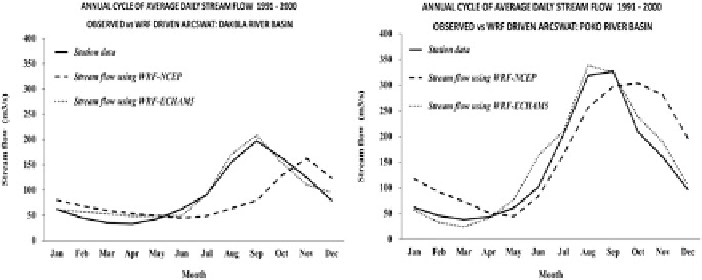Geoscience Reference
In-Depth Information
Fig. 17.8
Climatological Annual Cycles of Stream flow (
left
) Kontum observed station—Dakbla
river basin (
right
) Trung Nghia observed station—Poko river basin
simulated using WRF NCEP/NCAR reanalysis. This could probably be due to the
relatively coarser spatial resolution of the latter (
2:5
ı
3:75
ı
) compared to the former
(
1:8
ı
1:8
ı
). The stream flows over the two river basins chosen for study, Poko and
DakblaareshowninFig.
17.8
.
The future climate simulation of the RCM WRF spanned the period 2091-2100
driven by the GCM ECHAM5 T63 under the IPCC SRES A2 emission scenario.
This period has been considered in this study as the emission scenario shows clear
signal of change towards the end of the century. Just as the simulation for the
present-day climate, the RCM WRF derived estimates for future rainfall was used
to simulate future stream flow conditions.
For the assessment of future stream flow, the delta factor approach was under-
taken where the climate change factor was derived using the estimates of the future
climates and present day climates of the WRF-ECHAM5 simulations. This factor
is the difference between the future and the present day rainfall estimates. This
method is usually practiced by impact modellers as the difference between the future
and present day model output cancels the biases in the model output and gives out
the clear signal of climate change. Since the best available record of rainfall is the
station data, this change factor was added to the station data time series, which in
turn represents the changed future conditions of rainfall. The change factor added
station rainfall was then used as the input to the SWAT model to simulate future
stream flow. Such an application of delta factor for climate change studies have
been described by
Sushama et al.
(
2006
)and
Andersson et al.
(
2006
). A student
t-test was done to ensure that the climate signal is true and not a noise. This method
entails that a credible estimate of future stream flow could be obtained.
Figure
17.9
shows the stream flow thus derived over the two river basins Poko
and Dakbla. For clarity in comparison, the present day stream flow (shown as
'baseline') is overlaid on the future estimated stream flow that used the WRF-
ECHAM5 change factor as discussed above. Results show that, both over Dakbla
and Poko river basins, the future stream flow is expected to increase, especially
during the peak rainfall season. The Dakbla river basin shows a more pronounced

Search WWH ::

Custom Search